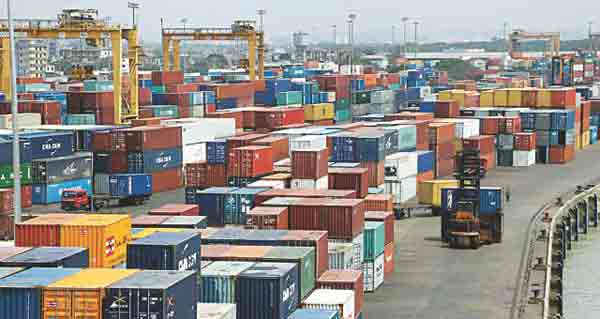

Chittagong port of Bangladesh
Dhaka, Bangladesh (BBN)- Bangladesh’s overall trade deficit crossed US$10-billion mark in the first seven months of this fiscal year (FY), 2017-18, following higher import payments against lower export receipts, officials said.
The deficit rose by 91.65 per cent or $4.84 billion to $10.12 billion in July-January period of FY 18, from $5.28 billion in the same period of the previous fiscal, according to the latest central bank statistics.
Talking to the BBN, a senior official of the Bangladesh Bank (BB), the country’s central bank, said higher import payment obligations, particularly for food grains, fuel oils and capital machinery, pushed up the overall trade deficit significantly in July-January period of FY 18 compared to the same period of FY 17.
The BB data showed that the overall import increased by more than 25.20 per cent to $31.18 billion in the period under review of FY 18, from $24.90 billion in the same period of the previous fiscal.
The central banker expects that the overall trade deficit may decrease in the coming months, if the upward trend of export earnings continues.
The country’s export earnings grew by 7.31 per cent to $21.05 billion in the first seven months of FY 18 against $19.62 billion in the same period of the previous fiscal.
“The steady growth of export earnings continued in February that may help narrowing the overall trade deficit in the near future,” the BB official explained.
In February 2018, export receipts stood at $3.07 billion, up by 13.53 per cent over the same month in the last calendar year. It was $2.70 billion in February 2017.
However, deficit in service trade also increased to $2.58 billion in the first seven months of FY 18, which was $1.99 billion in the same period of the previous fiscal. Trade in services includes tourism, financial service and insurance.
Meanwhile, the higher trade deficit pushed down the current-account balance significantly during the period under review, despite an uptrend in inward remittance.
Bangladesh’s current-account deficit reached $5.35 billion during July-January period of FY 18 against $890 million in the same period of the last fiscal. It was $4.74 billion a month ago.
The inflow of remittance, however, increased nearly 15 per cent to $8.13 billion in the first seven months of FY 18 from $7.07 billion in the same period of FY 17.
Besides, the ongoing higher trade gap put a pressure on the exchange rate, with the Bangladesh Taka (BDT) becoming weaker against the US dollar gradually.
The depreciating mode of BDT continues against the greenback despite of selling the US dollar by the central bank to the commercial banks to keep stable the country’s foreign exchange market.
The central bank so far sold a total of $1.64 billion to the commercial banks this fiscal year as part of its ongoing liquidity support for settling import payment obligations particularly for fuel oils, food grains and capital machinery.
But the exchange-rate management is mostly on the right track considering the overall economic activities of Bangladesh, according to exporters.
Though the country has good amount of foreign- exchange reserves, there is little scope to be complacent as pressure on import payments may go mounting further, they added.
They also said the authorities concerned will have to take effective measures immediately to boost export earnings as well as to increase the flow of inward remittance further for improving the current account balance position.
The experts also recommended strengthening monitoring for curbing less necessary imports.
Meanwhile, the financial account reached a surplus of $4.74 billion during July-January period of FY 18, which was $2.54 billion in the same period of FY 17.
Higher inflows of medium- and long-term loans helped to maintain a robust surplus in the financial account.
However, the gross inflow of foreign direct investment (FDI) increased by 1.58 per cent to $1.99 billion during July-January period of FY 18 from $1.96 billion in the same period of FY 17, the official data showed.
On the other hand, net FDI inflow dropped 2.21per cent to $1.10 billion from $1.13 billion.
Bangladesh’s overall balance of payments (BoP) slid to deficit of $1.03 billion in the first seven months of this fiscal, which was surplus of $2.19 billion in the same period of FY 17.
The BoP deficit increased significantly during the period under review of FY 18, as the country has made the highest-ever payment of $1.56 billion to Asian Clearing Union (ACU) against imports during the last two months (January-February), another BB official explained.
After the payment, the country's foreign exchange (forex) reserve came down to $31.93 billion on March 08 from $33.49 billion of the previous working day. It was $31.99 billion on Wednesday (March 14).
The reserves would, however, be enough to settle more than seven months of the country’s total import bills.
The central banker expects the overall BoP deficit may reduce in the coming months.
The BoP deficit was $354 million in July-December period of FY 18. It was $360 million in the first quarter (Q1) of the ongoing fiscal.
BBN/SSR/AD